Podcast: Play in new window | Download (Duration: 11:51 — 9.1MB)
Is it extinct? Is it alive? What is the difference between the ammonite and the nautilus? Did Kate get the two confused her whole life until a few months ago and thought they were both extinct? Maybe.
A fossilized ammonite shell:
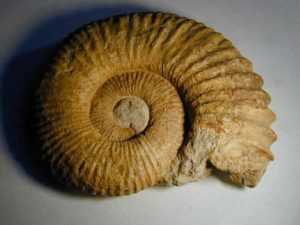
Another fossilized ammonite shell of a different shape:
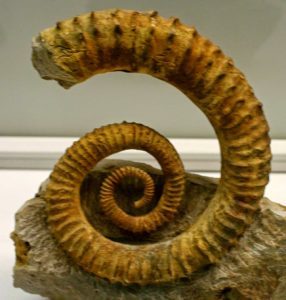
A third fossilized ammonite shell of a yet different shape:
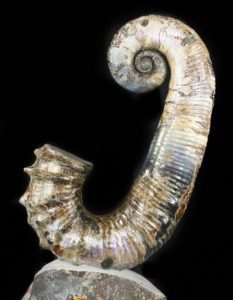
A gigantic fossilized ammonite shell:

A fossilized ammonite shell of gem quality, called an ammolite:
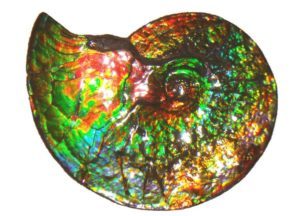
This is what an ammonite might have looked like when it was alive. I drew this myself IN MS PAINT because I couldn’t find anything online I liked. There’s 15 minutes of my life I won’t get back:
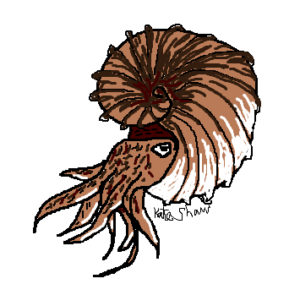
This is an alive and not extinct nautilus:
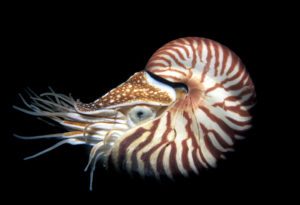
Another alive and not extinct nautilus:
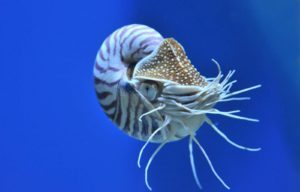
The slimy or crusty nautilus. Look, I don’t make these names up:
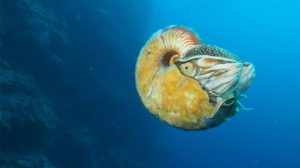
A nautilus tucked up in its shell and peeking out to see if that diver is going to eat it:
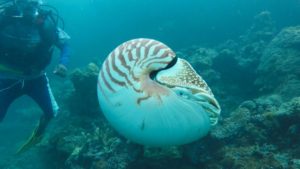
You can contribute to helping conserve the nautilus:
Show transcript:
Welcome to Strange Animals Podcast. I’m your host, Kate Shaw.
This week let’s learn about two groups of mollusks, ammonoids and nautiloids. One group is extinct, one is still around…but they both look a lot alike, and they’re way more interesting than the word mollusk makes them sound!
We’ll start with ammonoids, specifically ammonites. Ammonites first appear in the fossil record around 409 million years ago, but they died out at the same time as the dinosaurs, around 66 million years ago. Many ammonite fossils look like snail shells, but the shell contains sections inside called chambers. The largest chamber, at the end of the shell, was for the ammonite’s body, except for a thin tube that extended through the smaller inner chambers, which allowed the animal to pump water or air into and out of the chambers in order to make itself more or less buoyant in the water. Some ammonites lived at the bottom of the ocean in shallow water, but many swam or floated throughout the ocean.
Comparing ammonites to snail shells may not give you the right idea about ammonites, though. Even big snails are pretty small. While many ammonites were no larger than modern snails, many others were bigger than your hand, sometimes twice the size of your hand even if you have really big hands. But during the Jurassic and part of the Cretaceous, some ammonites got even bigger. One species grew almost two feet across, or 53 cm, another grew some 4 ½ feet across, or 137 cm, and one species grew as much as 6 ½ feet across, or 2 meters. It was found in Germany in 1895 and dates to about 78 million years ago. And it wasn’t actually a complete fossil. Researchers estimate that in life it would have been something like eight and a half feet across, or 2.55 meters.
We have a lot of ammonite fossils, and many of them are beautifully preserved. Some still show a mother-of-pearl layer, a lustrous, iridescent layer of shell that modern molluscs still form. Some ammonite fossils are so lustrous that they’re considered gems, called ammolites. Ammolites are usually polished and made into jewelry. In the olden days people thought ammonites were petrified snakes, and would sometimes even carve the end of the ammonite shell into a snake’s head.
Many fossil ammonites aren’t fossils of the actual shell. When an ammonite died, its empty shell would fill with sediment. Frequently the shell itself wasn’t preserved, but the sediment inside was. That gives us elaborate casts of the insides of ammonite shells, in such good condition that researchers can determine the internal anatomy of the shell. We know mosasaurs frequently ate ammonites because we have fossils with tooth marks that match mosasaur teeth.
There are so many ammonite fossils that paleontologists can date layers of rock by examining which species of ammonite appear in it, called index fossils. Different species frequently had much different shells, some smooth, some with spines or ridges, with tight coils or open coils. Some didn’t coil at all, and instead were straight or had only one or two bends.
But despite all these thousands upon thousands of ammonite fossils, we still don’t know what the animal’s soft parts looked like. Hardly any impressions of ammonite bodies are preserved, only the shells. But ammonites are related to cephalopods like squid, so researchers believe they probably had tentacles.
Nautiloids are also cephalopods. They’re related to ammonites but not closely, about as closely as they’re related to squid. And nautiloids are still alive.
I only found that out recently. A few months ago I came across a picture of a man holding a big snail-like shell with eyes and a bunch of small tentacle things sticking out of the end. I thought it was photoshopped, because I knew those things were extinct! Then I realized that I’ve had nautilus and ammonite mixed up my whole life, and thought they were both extinct and basically the same animal.
They do look a lot alike. Nautilus shells are smooth and rounded like a snail shell, and like the ammonite, nautilus shells also contain chambers filled with gas that keeps the animal from sinking. The nautilus’s body is in the last chamber and extends outside of the shell, with a pair of simple eyes, a beak-like mouth, and as many as 90 small tentacles around the mouth. The top of the shell is striped with brown, while the bottom is white.
Nautilus tentacles are retractable and don’t have suckers the way other cephalopod tentacles do. They do have ridges and secrete sticky mucus that helps them keep hold of their prey. The nautilus also has tentacles around its eyes that are different from its mouth tentacles, and researchers think they act as sensory organs, detecting scent trails in the water. When a nautilus wants to rest, it holds onto a rock with its mouth tentacles so it won’t drift away.
Like squid, the nautilus has a tongue-like structure called a radula, which is studded with exactly nine teeth that it uses to cut up pieces of its prey, mostly crustaceans. It also eats carrion. Like other cephalopods, the nautilus has blue blood instead of red since it contains hemocyanin instead of hemoglobin. Also like squid and other cephalopods, the nautilus has a siphon, properly called a hyponome. In the nautilus, the hyponome is a flap that’s folded over to form a tube, instead of an actual tube in squid and octopus. The animal sucks in and expels water through the hyponome, which propels it through the ocean. If it’s threatened, the nautilus can actually withdraw all the way into its shell like a snail, covering the entrance with two large, folded tentacles.
The first fossil nautiloids are found in rocks dating to the Cambrian period, some 500 million years ago. Earlier nautiloids are sometimes straight, sometimes slightly curved, and sometimes coiled like ammonite shells. Even so, overall the nautilus hasn’t changed much since the Cambrian. Like the ammonite, some species of nautiloid once reached over 8 feet across, or 2.5 meters.
Today there are only six species of nautilus left, and they’re endangered due to habitat loss, pollution, and poaching. The shells of larger individuals can be worth a few hundred dollars to collectors, and while selling the shells is illegal in many countries, as long as there are unscrupulous or just clueless people who buy the shells, poaching of nautiloids will continue to be a problem. A good rule is that if you’re a tourist and someone is selling any kind of animal part, don’t buy it. Even if you think it’s harmless, you might be contributing to the extinction of an animal—plus, it’s probably going to get confiscated by customs anyway.
The problem is that the nautilus matures very slowly. It lives to be over 20 years old, but it isn’t mature until it’s about 15 years old. Its eggs take a long time to hatch too. So the nautilus is slow to recover from overhunting, which makes it vulnerable to extinction.
One species of nautilus is so rare it’s only been seen a few times, and hadn’t been seen in more than 30 years until one was spotted in 2015 off the coast of Papua New Guinea. It’s called Allonautilus scrobiculatus, and unlike other nautilus species, its shell is covered with a thick coating of hairy slime that gives it its popular name, the slimy nautilus or crusty nautilus. It grows to about 8 inches across, or 20 cm. Its close relative Allonautilus perforates is even rarer. In fact, it’s never been seen alive, and researchers don’t know much about it since all they have to study are empty shells found drifting in the water. It grows to about 7 inches across, or 18 cm.
Most living nautiloids are about that size, but the biggest is a subspecies of the chambered nautilus, often called the emperor nautilus. Before you get too excited, though, the biggest ones only grow to about ten inches across, or 25 cm.
Nautiloids don’t like water that’s too warm so they usually live near the bottom of the ocean, although their shells can’t withstand the pressures of abyssal depths. If a nautilus descends too far, its shell implodes and it dies instantly, like a hapless diver in a malfunctioning bathysphere. Nautiloids live in the Indo-Pacific Ocean and like the deeper parts of coral reefs.
So why did ammonites die out during the Cretaceous-Paleogene extinction event while nautiloids didn’t? Researchers think ammonites laid eggs that floated near the top of the ocean, while nautiloids lay eggs that stay on the bottom of the ocean. Specifically, female nautiloids attach their eggs to rocks in warm water, which take up to a year to hatch. Eggs at the bottom of the ocean were protected from most of the effects of the meteor impact, while those near the surface were killed.
Is it possible that some ammonites survived and still live in the deep sea, unknown to humans? I’m going to say probably not. Ammonites shared a lot of physical similarities with nautiloids, so they probably weren’t able to live in the deep sea without imploding. While it would be amazing if scientists discovered a living ammonite, we should celebrate that the humble nautilus is definitely still alive. It’s still blowing my mind, to be honest.
If you’d like to help nautilus conservation efforts, you can visit save the nautilus.com for more information. I’ll put a link in the show notes.
You can find Strange Animals Podcast online at strangeanimalspodcast.com. We’re on Twitter at strangebeasties and have a facebook page at facebook.com/strangeanimalspodcast. If you have questions, comments, or suggestions for future episodes, email us at strangeanimalspodcast@gmail.com. If you like the podcast and want to help us out, leave us a rating and review on Apple Podcasts or whatever platform you listen on. We also have a Patreon if you’d like to support us that way.
Thanks for listening!